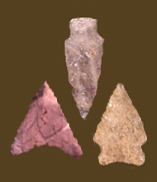
|
KIRK CORNER NOTCHED
Chronology The Kirk Corner Notched point dates to the Early Archaic period. Justice (1987) suggests a date range of 9500 to 8900 BP (approximately 8800-8100 BC in calendar years) for the Kirk Corner Notched Cluster, but that group includes the Palmer point, which Coe (1964) argues was the antecedent of the Kirk. The Virginia Department of Historic Resources (www.dhr.virginia.gov) uses a range of 9400 to 8500 BP (8600-7550 BC). Steponaitis (1980) places the Kirk Corner Notched between 9200 and 8900 BP (8400-8100 BC). At the St. Albans site in West Virginia, Broyles (1971) obtained radiocarbon dates of 6900 +/- 320 BC (approximately 8100 BC calendar) and 6850 +/- 320 BC (approximately 8000 BC) from strata containing this type. On the Nottoway River in Virginia, Kirk Corner Notched points were recovered below the Decatur and above the Fort Nottoway (Big Sandy) points (McAvoy and McAvoy 1997). At the stratified Pig Point site in Anne Arundel County, Maryland, a probable Kirk Corner Notched was recovered in a layer with two hearths that produced three radiocarbon dates ranging from 7530 +/- 50 BP to 7290 +/- 50 BP, or approximately 6400-6200 BC (Luckenbach 2011a). In the Northeast, radiocarbon dates ranging from 6825 BP to 7550 BP have been reported, but largely rejected as too young (Funk 1993; Justice 1987). In light of the Pig Point site dates, perhaps the Kirk Corner Notched continued in use in the North long after it disappeared in the Southeast. Description Blade: The blade is triangular, with straight or excurvate edges. The edges are serrated (sometimes deeply) and occasionally beveled, which would suggest re-sharpening. Haft Element: Bases may be as wide as—or wider—than the blade and are generally straight or slightly concave or convex, and can be ground. Kirk Corner Notched points have well-defined shoulders; many are straight, but most have barbs projecting toward the base, forming a notch 10 to 14 mm wide. Size: Length ranges from 40 to 100 mm, with an average of 60mm. Width ranges from 20 to 45 mm, with an average of 30 mm. Thickness ranges from 6 to 12 mm, with an average of 8 mm. Technique of manufacture: The basic blade appeared to have been made with broad, shallow, soft percussion flakes. The edges were then shaped by pressure flaking, with the serrated edges produced last. Some exhibit parallel flaking. Material: In a sample of 46 Kirk Corner Notched points from the lower Patuxent drainage, Steponaitis (1980) reported that 40% were quartz, followed by rhyolite (32%), quartzite (23%), and chert (5%). In the area surrounding Zekiah Swamp on the lower Potomac, Wanser (1982) found that 57% of 46 Kirk Corner Notched points were quartz, with 22% rhyolite, 15% quartzite, and 6% chert and jasper. In the Monocacy River drainage, 59% of Kirks (all types) are rhyolite (Kavanagh 1982), while chert is the predominate material in the middle Potomac River Valley (Hranicky 2002). In the Hagerstown Valley, a majority of Kirk points were rhyolite (particularly in the eastern areas closest to rhyolite quarries), followed by lesser amounts of chert, quartzite, and jasper (Stewart 1980). In Western Maryland, Kirk points are commonly made from local and non-local cherts, as well as siltstone and occasionally rhyolite (Wall 1991, 1992). In Delaware, Kirk Corner Notched points are almost all chert or jasper (Custer 1996a). Discussion Defined in Literature Coe (1964) originally defined the type from examples recovered at the Hardaway site in North Carolina. Broyles (1971) also discusses this type based on points recovered from the St. Albans Site in West Virginia. References |
![]()
Search by Shape:
(See Projectile Point Typology) |

|
Thank you for visiting our website. If you have any
questions, comments, Copyright © 2002 by |

|

 Defining Attributes
Defining Attributes